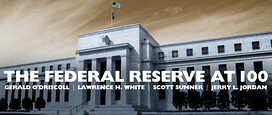Last Thursday, November 14, two discussions about the policies and practices of the U.S. central bank were occurring only a few miles apart, but they may as well have been on opposite sides of the planet. In the U.S. Senate, a committee was questioning the nominee to become the next chairman of the Fed, while over at the Cato Institute’s Hayek auditorium scholars were looking back over the 99-year history of the Fed and pondering whether the future would be more of the same.
Neither discussion came to grips with the crucial issue of when and how the Fed eventually ends and ultimately unwinds its massive asset purchases, known as QE. What should “fed-watchers” be looking at to conclude that enough is enough, it is time to end “pedal to the metal” monetary actions? The Fed is backpedaling off the idea that there is a magic rate of unemployment that will signal the end is near. Scott Sumner suggests nominal GDP will signal when there is too much heat under the kettle. But then what? Nominal GDP jumped from 2.4% in QII to 4.7% in QIII, as the personal consumption price index went from a small decline in the second quarter to 1.9% increase in the third. Suppose NGDP rises further to 6% or higher in the fourth quarter? What should the FOMC instruct the trading desk to do? There is no Federal funds market; the Fed portfolio has no Treasury bills that can be sold.
My point is that there are no rules guiding central bank actions; there is no one inside or outside the Fed who can say anything meaningful about the future. Meaningful congressional oversight is not possible. Neither foreign exchange nor domestic bond markets are providing discipline. This cannot end well.

